Past Year Questions: Theories of Seepage, Spillways & Miscellaneous | Topic wise GATE Past Year Papers for Civil Engineering - Civil Engineering (CE) PDF Download
Q1: At the foot of a spillway, water flows at a depth of 23 cm with a velocity of 8.1 m/s, as shown in the figure.
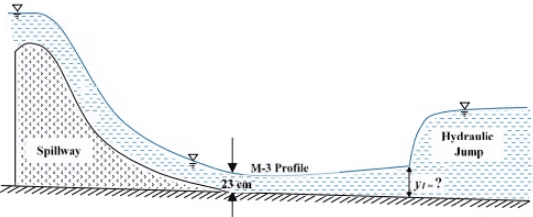 The flow enters as an M-3 profile in the long wide rectangular channel with bed slope = 1/1800 and Manning's n = 0.015. A hydraulic jump is formed at a certain distance from the foot of the spillway. Assume the acceleration due to gravity, g = 9.81 m/s2. Just before the hydraulic jump, the depth of flow y1 (in m, round off to 2 decimal places) is _______ [2019, Set-1]
The flow enters as an M-3 profile in the long wide rectangular channel with bed slope = 1/1800 and Manning's n = 0.015. A hydraulic jump is formed at a certain distance from the foot of the spillway. Assume the acceleration due to gravity, g = 9.81 m/s2. Just before the hydraulic jump, the depth of flow y1 (in m, round off to 2 decimal places) is _______ [2019, Set-1]
Ans: 0.41 to 0.43
Sol:
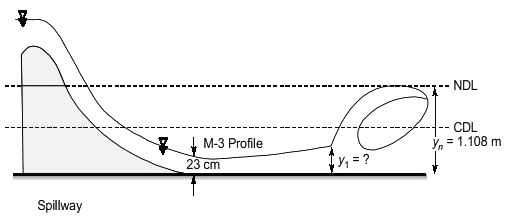 y = 0.23m
y = 0.23m
V = 8.1m/s
q = Vy = 0.23 x 8.1
= 1.863m3/s − m
S0 = 1/800
D = 0.015
yn = Normal depth of flow
R = y for wide rectangular channel
By Manning's equation

Q2: A confined aquifer of 15 m constant thickness is sandwiched between two aquicludes as shown in the figure. [2019, Set-2] The heads indicated by two piezometers P and Q are 55.2 m and 34.1 m, respectively. The aquifer has a hydraulic conductivity of 80 m/ day and its effective porosity is 0.25 . If the distance between the piezometers is 2500 m, the time taken by the water to travel through the aquifer from piezometer location P to Q (in days, round off to 1 decimal place) is
The heads indicated by two piezometers P and Q are 55.2 m and 34.1 m, respectively. The aquifer has a hydraulic conductivity of 80 m/ day and its effective porosity is 0.25 . If the distance between the piezometers is 2500 m, the time taken by the water to travel through the aquifer from piezometer location P to Q (in days, round off to 1 decimal place) is
Ans: 924 to 926
Sol:
Discharge velocity,
V = ki
= 0.6752m/day
Porosity, n = 0.25
∴ Seepage velocity,

= 2.7008m/day
Time taken = L/Vs
= 2500 / 2.7008 = 925.65days
Q3: If the path of an irrigation canal is below the bed level of a natural stream, the type of cross-drainage structure provided is [2019, Set-1]
(a) Level crossing
(b) Super passage
(c) Aqueduct
(d) Sluice gate
Ans: (b)
Sol:
Irrigation canal below the bed level of a natural stream
→Super passage
Q1: Group I contains three broad classes of irrigation supply canal outlets. Group II presents hydraulic performance attributes.
Group I
P. Non-modular outlet
Q. Semi-modular outlet
R. Modular outlet
Group II
1. Outlet discharge depends on the water levels in both the supply canal as well as the receiving water course
2. Outlet discharge is fixed and is independent of the water levels in both the supply canal as well as the receiving water course
3. Outlet discharge depends only on the water level in the supply canal
The correct match of the items in Group I with the items in Group II is
(a) P-1; Q-2; R-3
(b) P-3; Q-1; R-2
(c) P-2; Q-3; R-1
(d) P-1; Q-3; R-2 [2017 : 2 Marks, Set-I]
Ans: (d)
Non-modular outlet: These are the outlets whose discharge depends on the difference in water levels in the distributing channel and the water course. The discharge of such outlets, therefore, varies with the variation of the water levels in the distributing channel and the water course.
Semi-modular outlet: These are the outlets whose discharge varies with the variation of the water level in the distribution channel but it is independent of the water level in the water course, so long as the minimum working head required for their working is available.
Modular outlet: These are the outlets whose discharge is independent of the water levels in the distributing channel and the water course, within reasonable working limits. In other words modular outlets maintain a constant discharge irrespective of variation of the water levels in the distributing channel and the water course.
Q2: Profile of a weir on permeable foundation is shown in figure I and an elementary profile of upstream pile only case’ according to Khosla’s theory is shown in figure II. The uplift pressure heads at key points Q, R and S are 3.14 m, 2.75 m and 0 m, respectively (refer figure II)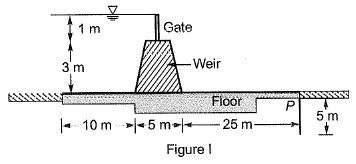
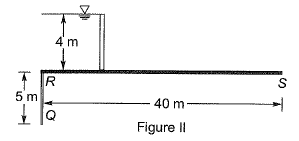
What is the up lift pressure head at point P downstream of the weir (junction of floor and pile as shown in the figure-1)? [2016 : 1 Mark, Set-Il]
(a) 2.75 m
(b) 1.25 m
(c) 0.8 m
(d) Data not sufficient
Ans: (b)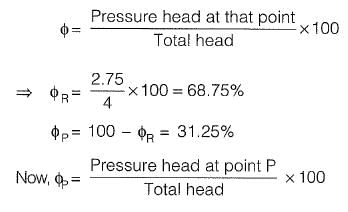

Q3: A conventional flow duration curve is a plot between
(a) Flow and percentage time flow is exceeded
(b) Duration of flooding and ground level elevation
(c) Duration of water supply in a city and proportion of area receiving supply exceeding this duration
(d) Flow rate and duration of time taken to empty a reservoir at that flow rate [2014: 1 Mark, Set-I]
Ans : (a)
FAQs on Past Year Questions: Theories of Seepage, Spillways & Miscellaneous - Topic wise GATE Past Year Papers for Civil Engineering - Civil Engineering (CE)
| 1. What are the main theories of seepage in engineering practices? |  |
| 2. How do spillways function in dam engineering? |  |
| 3. What are the types of spillways commonly used in hydraulic engineering? |  |
| 4. What is the significance of seepage control in dam safety? |  |
| 5. How can engineers assess seepage through soils and rocks? |  |
















